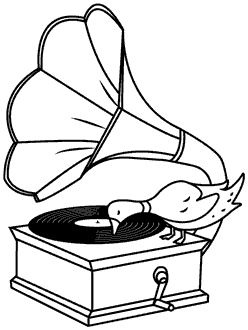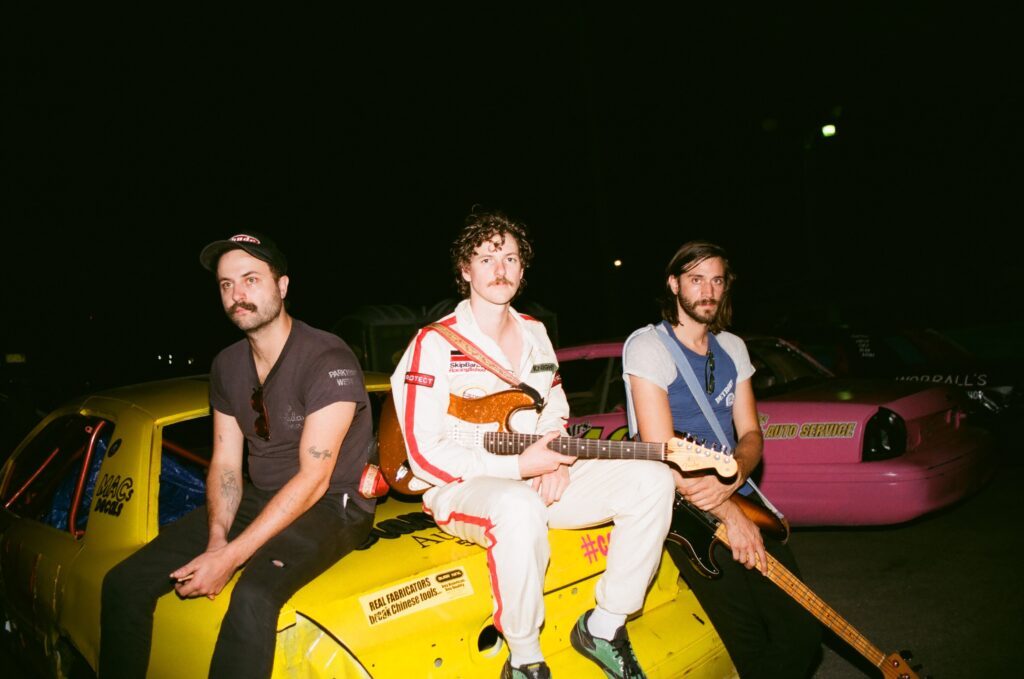
On their new album Good For You, Houndmouth share a collection of songs set in places as far-flung as the Alamo and the Hudson River, each populated by a motley cast of characters: fairy-tale princesses and vampires, parking-lot lovers and wanna-be beauty queens. The fourth full-length from the Indiana-bred band—vocalist/guitarist Matthew Myers, drummer/vocalist Shane Cody, and bassist/vocalist Zak Appleby—the result is a lovingly gathered catalogue of those wild and fleeting moments that stay lodged in our hearts forever, taking on a dreamlike resonance as years go by.
Produced by Brad Cook (Waxahatchee, Hiss Golden Messenger) and mixed by Jon Ashley (The War on Drugs, B.J. Barham), Good For You came to life at Houndmouth’s longtime headquarters, a 19th-century shotgun-style house decked out in gold wallpaper and crystal chandeliers. “It was my grandparents’ place, and after they passed we kept it the exact same, full of all their old stuff,” Cody explains. Over the course of a year spent holed up at the so-called Green House, Houndmouth slowly shaped the warm and unhurried sound of Good For You. “Except for the first EP we’d never recorded in our own space before,” says Myers. “It was perfect because we all felt so comfortable, and there were no time constraints on anything.”
In a departure from the shambolic spirit of past work like Little Neon Limelight (Houndmouth’s 2015 breakout, featuring the gold-certified “Sedona”), Good For You bears a hi-fi minimalism that beautifully illuminates its finespun storytelling. “From working with Brad and Jon we learned to go for the simplest parts that best support the melody, and to let the frequencies take up more space in the songs,” says Myers. On the album-opening title track, Houndmouth bring that approach to a sweetly languid breakup song set against the surreal backdrop of the Kentucky Derby (“I wrote that before Covid, but at the time I was sort of emotionally going through a pandemic,” Myers points out). On “Miracle Mile,” Houndmouth pay homage to the many misfits they’ve met on the road, including a woman they’ve nicknamed after the Greek god of wine and ritual madness (“Sweet Dionysus/She never really liked us/Hangs on and stays too long/And then supplies us all with vices”). One of the most heavy-hearted moments on Good For You, “McKenzie” looks back on an ex-girlfriend of Cody’s and spins a tender portrait of wasted longing (“Everybody’s coming over/To smoke and go nowhere/Once a steady conversation/Just a bunch of hot air”). And on “Cool Jam,” Houndmouth eulogize a doomed romance, embedding their lyrics with so much broken wisdom (e.g., “Ain’t no heaven when you’re having a good time”).
On its closing track “Las Vegas,” Good For You shifts into a far rowdier mood, offering up a freewheeling anthem that once again reveals Houndmouth’s ability to build a novel’s worth of tension in just a few lines (“You wore makeup for three days straight/Half a Xanax for the holidays/By the look on your face/You’re rolling eights the hard way”). Working from a demo they’d laid down years before, the band produced “Las Vegas” on their own in the frenetic final session for the album. “We had a mic at one end of the hallway, and we were all just screaming the harmonies together from the other end,” Myers notes. In assembling the tracklist for Good For You, Houndmouth nearly withheld the song due to its outlier status, but ultimately found its joyfully unhinged energy well-suited to a world waking up from a year of grief and isolation. “I love how you can hear the difference between Brad really anchoring us down on all the rest of the album, and then the chaos of us handling that one ourselves,” says Cody.
For Houndmouth, the making of Good For You allowed for a major leap forward in their songwriting and sound while recalling the pure abandon of the band’s early days. “I remember the first time I ever came to the Green House and saw what was happening here and I thought, ‘I’m never leaving this place,’” says Myers, who met Appleby and Cody in high school and started collaborating with them in college. “This album felt like being back in that time again, only now everything’s a little more dialed-back and cared-for. It was like a return to the way we fell in love with playing music together.”

Buffalo Nichols
Since his earliest infatuations with guitar, Buffalo Nichols has asked himself the same question: How can I bring the blues of the past into the future? After cutting his teeth between a Baptist church and bars in Milwaukee, it was a globetrotting trip through West Africa and Europe during a creative down period that began to reveal the answer.
“Part of my intent, making myself more comfortable with this release, is putting more Black stories into the genres of folk and blues,” guitarist, songwriter, and vocalist Carl “Buffalo” Nichols explains. “Listening to this record, I want more Black people to hear themselves in this music that is truly theirs.” That desire is embodied in his self-titled debut album—Fat Possum’s first solo blues signing in nearly 20 years—composed largely of demos and studio sessions recorded between Wisconsin and Texas.
Born in Houston and raised in Milwaukee’s predominantly Black North end, the guitar was Nichols’ saving grace as a young man. The instrument captured his fascination, and provided him with an outlet for self-expression and discovery in isolation. While other children chased stardom on the field, court, or classroom, Nichols took to his mother and siblings’ music collections, searching feverishly for riffs to pick out on his instrument. Sometimes, this dedication meant listening to a song 200 times in order to wrap his mind around a chord; as a teenager, it even routinely meant staying home from school to get extra practice.
It would’ve required a more than arduous journey across town to find a secular circle to jam with in a city still reeling from redlining and segregation, so despite a lack of a religious upbringing, Nichols went sacred. A friend invited the teenage guitarist to church for a gig and the opportunity proved to be Nichols’ much-needed breakthrough to music circles in the area. But over the following years, he began to feel overextended, and abandoned the demanding grind of a supporting role in nearly ten Milwaukee scene bands, none of which bore his vision as a lead performer. “I was happy with all the stuff that I was doing, and I was learning, but I wasn’t playing anything that was very creatively fulfilling,” Nichols says. “I needed the time and space. I was overwhelmed.”
Stints in college and in the workforce led him overseas, where the appreciation of African-American folkways lit a renewed spark in Nichols. It was the bustling of jazz in places like the working class areas of Ukraine, or in Berlin cafes where expatriate Black Americans routinely treat fans to an enchanting evening of blues, that would lead to his a-ha moment. Nichols returned home to America, meditating on his own place in the music that holds the country’s truest values and rawest emotions between bar and measure. “Before this trip, it was hard for me to find that link between all these blues records I heard and people who are living right now. I figured out it’s not a huge commercial thing, but it still has value. So, I came home and started playing the blues more seriously, doing stuff with just me and my guitar,” Nichols says.
Nichols admits that anger and pain are realities that color the conversations and the autobiographical anecdotes behind his observational, narrative-based approach to songwriting. However, with his lyricism on Buffalo Nichols, he intends to provide a perspective that doesn’t lean heavily into stereotypes, generalizations or microaggressions regarding race, class and culture. The album sees Nichols wrestling with prescient topics, such as empathy and forgiveness on the poignant, ever-building melody of “How to Love;” regret and loss on moving, violin-inflected “These Things;” and the pitfalls of lives lived too close to the edge on the smooth, dynamic “Back on Top.” On the tender, aching album opener and lead single “Lost & Lonesome,” he gives listeners what he describes as a “glimpse into the mind of that traveler looking for a friend and a place to call home;” inspired by his years traveling alone, looking for a place for his passions to fit in, even if temporarily, the track is an ode to exploration and the creative ingenuity of isolation. At the forefront of each song is Nichols’ rich voice and evocative, virtuosic guitar-playing, augmented on half of the nine tracks by a simple, cadent drum line.
While acknowledging the joy, exuberance and triumph contained in the blues, Nichols looks intently at the genre’s origins, which harken back to complicated and dire circumstances for Black Americans. With this in mind, Nichols says there is a missing link, which he’s often used as a compass: Black stories aren’t being told responsibly in the genre anymore. To begin changing that, Buffalo Nichols gets the chance to tell his own story in the right way.





